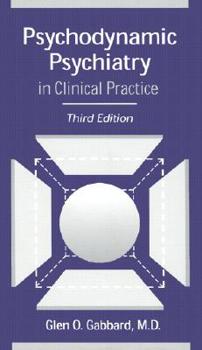Psychodynamic Psychiatry in Clinical Practice
Select Format
Select Condition 
Book Overview
Long-awaited, this fifth edition of Psychodynamic Psychiatry in Clinical Practice has been thoroughly revised in light of the new DSM-5 categories while maintaining its focus on the individual... This description may be from another edition of this product.
Format:Hardcover
Language:English
ISBN:1585620025
ISBN13:9781585620029
Release Date:May 2000
Publisher:American Psychiatric Publishing
Length:616 Pages
Weight:2.50 lbs.
Dimensions:1.5" x 6.2" x 9.3"
Customer Reviews
5 ratings
A must read for psychiatrists
Published by Thriftbooks.com User , 17 years ago
This text is a wonderfully clear and easily understood book. Gabbard looks at the fundamentals of dynamic psychiatry and explains the principles behind the major schools of psychodynamic theory in such a way that even I can understand! In this edition, he adds some of the latest findings on neurobiology, offering a compelling integration of biological and psychological theories. This is the second edition I have bought, and for someone who usually avoids buying even one textbook, to have bought two of the same is saying something.
Practical emphasis on empirical validation
Published by Thriftbooks.com User , 18 years ago
I teach those evil, mean behavioral and cognitive courses that all of you hate. Bwaaahahahahaaaaah. Even so... Add me to the list of people who heartily endorse this new edition of a classic. I use it as a teaching tool and as a reference, and clinical psychology students generally rave about it. A book like this one is essential at a time when psychodynamic approaches are fighting for their proverbial lives. It keeps pace with the DSM-IV-TR, and with rapid advances in neuroscience and clinical research. As before, it is enormously practical. It continues to provide clinical examples, insight, and wisdom related to each DSM diagnosis. As before, its style is accessible to students and clinicians alike, including those who are not psychodynamically oriented. If I was teaching an introductory course on psychdynamic psychology, this is the text I would use. Gabbard's book contains the following: (1) A lucid introduction to the foundations of dynamic psychiatry. Topics covered include the patient's subjective experience, the role of the unconscious, psychic determinism, expression of the past in the present, resistance, and the role of neurobiology; (2) An introduction to theory, including ego psychology, object relations theory, self psychology, and attachment theory; (3) A multi-chapter discussion of clinical assessment and treatment, including sections on psychodynamic considerations of medication and hospitalization; (4) Coverage of Axis I disorders (schizophrenia, affective disorders, anxiety disorders, dissociative disorders, sexual dysfunctions, substance-related disorders and eating disorders, and cognitive disorders); (5) Coverage of Axis II disorders, with emphasis on the cluster B This is disorders. There are separate chapters for borderline, narcissistic, antisocial, and hysterical-histrionic disorders. The clinical chapters begin by discussing presentation as it relates to the 4 major dynamic schools, and then discuss assessment, and management. In this new edition, relevant biological research is integrated into the discussion. My kind of book: it takes old-time theories, case studies, and new research, and integrates them in a way that enhances clinical practice.
Gabbard has done his homework!
Published by Thriftbooks.com User , 19 years ago
this is a wonderful book. it is well-organized and puts the often elusive concept of psychodynamic theory into real, practical considerations and methods. it includes basic principles, information on defense mechanisms (very useful), and a great deal of information on various psychodynamic theoretical perspectives. the chapters on understanding and treating personality disorders were my favorite, and the author spent a great deal of time on cluster b personality disorders, probably the most often seen and difficult to treat of the personality disorders. i particularly liked the chapter on borderline personality disorder. throughout the book, the theory and concepts are easy to read and understand, and the interventions are practical and well-explained.
Gabbard Hits the Mark Again
Published by Thriftbooks.com User , 24 years ago
Gabbard's Third Edition of Psychodynamic Psychiatry keeps an already classic psychodynamic analysis of the DSM IV up to date with the lastest revisions of the DSM IV. It is what we have come to expect from Gabbard and more. Listening to and hearing our patients remains as necessary now, and even more necessary now, precisely because of the chemical interventions which are now available.
A Resident's Dream to Understanding the Psychiatric Patient
Published by Thriftbooks.com User , 24 years ago
As a third year resident in psychiatry, the utilization of dynamic therapy in the treatment of my patients was daunting. To fully understanding them, would I need to read all of the works of Freud and Jung (and numerous other masters in the field). Dr. Gabbard succintly puts all of the current theories of dynamic therapy into one crisp, easy to read text. The only unfortunate thing about this book is that a third edition is arriving in stores soon.






